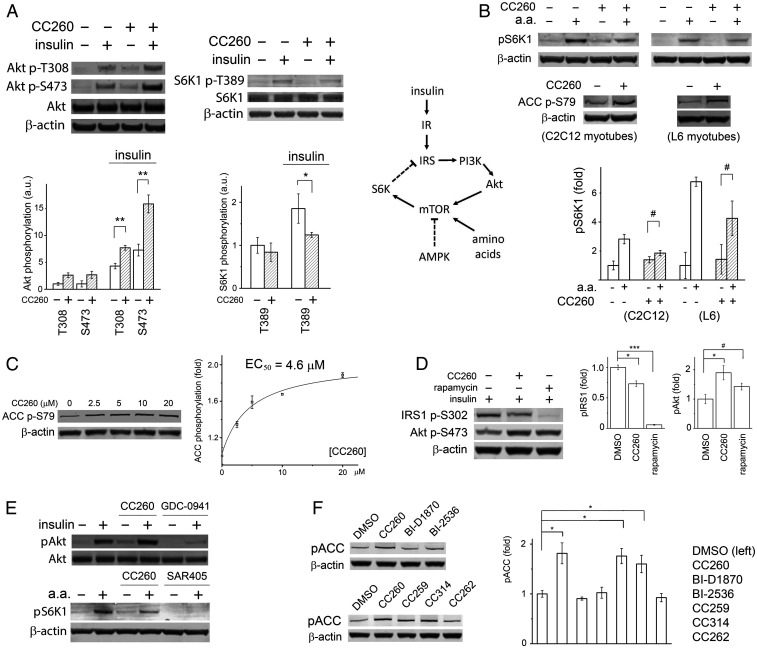Fig. 3.
PI5P4K inhibition activates AMPK in myotubes. (A) CC260 enhanced insulin-induced Akt phosphorylation at both Thr-308 and Ser-473 but suppressed S6K phosphorylation by mTORC1. C2C12 myotubes were treated with 10 μM CC260 in a serum-free DMEM overnight before being stimulated by 15 nM insulin for 30 min (n = 3). (B) mTORC1 receives major inputs from growth factors through the PI3K/Akt pathway, amino acids, AMPK, stress, and hypoxia (the latter two not shown in the simplified diagram) (44). IR, insulin receptor; IRS, insulin receptor substrate. In both C2C12 and L6 myotubes, CC260 did not prevent amino acids from activating mTORC1. The myotubes were treated with 10 μM CC260 overnight in serum- and amino acid–free media before being transferred to serum-free media with amino acids and cultured for an additional 30 min (n = 3). (C) CC260 activated AMPK in a dose-dependent manner. C2C12 myotubes were treated with various concentrations of CC260 in a serum-free DMEM overnight before Western blot analysis (n = 3). The y-axis represents the effect (fold change) of the compound on ACC phosphorylation relative to DMSO control. (D) Enhanced Akt phosphorylation correlated with reduced IRS1 phosphorylation at Ser-302, caused by either CC260 or rapamycin treatment. C2C12 myotubes were treated with either 10 μM CC260 (overnight) or 10 nM rapamycin (1 h) and then stimulated with 15 nM insulin for 30 min (n = 3). (E) PI3K-α inhibitor GDC-0941 eliminated insulin-induced Akt phosphorylation at Ser-473. Vps34 inhibitor SAR405 prevented mTORC1 activation by amino acids. CC260 had neither of these effects. Although CC260 reduced S6K phosphorylation in myotubes, it did not inhibit mTOR/FRAP1 from the protein kinase panel. C2C12 myotubes were treated with 10 μM CC260 or 1 μM GDC-0941 overnight before being stimulated by 15 nM insulin for 30 min (n = 3). C2C12 myotubes were treated with 10 μM CC260 or 10 μM SAR405 overnight in an amino acid–free medium before being transferred to a standard medium with amino acids for 30 min (n = 3). (F) Parent compounds BI-D1870 and BI-2536, and control compound CC262, did not increase ACC phosphorylation, whereas CC259 and CC260, equipotent toward PI5P4Kα and PI5P4Kβ, and CC314, more specific for PI5P4Kβ, activated AMPK. C2C12 myotubes were treated with 10 μM compound overnight in serum-free media before Western blot analysis (n = 3). Quantifications of the Western blots are shown as means ± SEM, * indicates P ≤ 0.01, ** indicates P ≤ 0.001, *** indicates P ≤ 0.0001, and # indicates P ≤ 0.05 based on Student’s t test.

